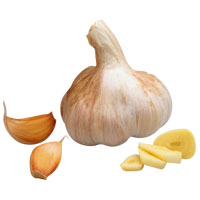Fit and Fast Recipes
Garlic

Preparation, Uses, & Tips
Garlic is usually peeled before it is used. Among the exceptions are roasted garlic bulbs and the famous dish, “chicken with 40 cloves of garlic,” in which unpeeled garlic cloves are baked with chicken in a broth until they become sweet and butter-soft. Crushing, chopping, pressing, or pureeing garlic releases more of its essential oils and delivers a sharper, more assertive flavor than slicing or leaving it whole.
Garlic is an essential element in cuisines around the world, especially those of China, India, France, Greece, Italy, and the Mediterranean area. It is used to flavor everything from vegetables to poultry, beef, lamb, and seafood, as well as dressings, sauces, casseroles, and soups. Experiment to see how much garlic suits your taste buds. However, in general, 1 pound (.45kg) of vegetables or beans will benefit from 2 to 4 cloves of fresh garlic.
One well-known but unfortunate side effect of garlic is that its components remain present in the body long after it’s consumed, affecting both breath and skin odor. While chewing on a sprig of fresh parsley can help, no perfect remedy is yet known.
Raw garlic has a vibrantly sharp, biting flavor, which some find to be too strong. Cooking eliminates this bite and softens its flavor.
Roasting garlic gives it a smooth, soft, nutty flavor. To roast, place unpeeled cloves in the oven at 350°F (177°C) for about 15 minutes; peel, mash, and use in purees, sauces, and soups.
Copyright © 2025 TraceGains, Inc. All rights reserved.
Learn more about TraceGains, the company.
The information presented in the Food Guide is for informational purposes only and was created by a team of US–registered dietitians and food experts. Consult your doctor, practitioner, and/or pharmacist for any health problem and before using any supplements, making dietary changes, or before making any changes in prescribed medications. Information expires December 2025.










